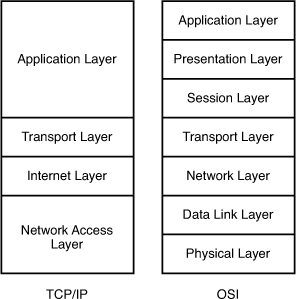CCNA – OSI & TCP/IP Model
Note: If you are not sure about OSI Model, please read our OSI Model tutorial.
Question 1
Explanation
The picture below shows the comparison between TCP/IP model & OSI model. Notice that the Internet Layer of TCP/IP is equivalent to the Network Layer which is responsible for routing decision.

Question 2
Question 3
Explanation
When upgrading new version of the IOS we need to copy the IOS to the Flash so first we have to check if the Flash has enough memory or not. Also running the new IOS may require more RAM than the older one so we should check the available RAM too. We can check both with the “show version” command.
Question 4
Explanation
The Network layer is responsible for network addressing and routing through the internetwork. So a ping fails, you may have an issue with the Network layer (although lower layers like Data Link & Physical may cause the problem).
Question 5
Question 6
Explanation
The Transport Layer segments data into smaller pieces for transport. Each segment is assigned a sequence number, so that the receiving device can reassemble the data on arrival.
The Transport Layer also uses flow control to maximize the transfer rate while minimizing the requirements to retransmit. For example, in TCP, basic flow control is implemented by acknowledgment by the receiver of the receipt of data; the sender waits for this acknowledgment before sending the next part.
-> A is correct.
The Data Link Layer adds physical source and destination addresses and an Frame Check Sequence (FCS) to the packet (on Layer 3), not segment (on Layer 4) -> B is not correct.
Packets are created when network layer encapsulates a segment (not frame) with source and destination host addresses and protocol-related control information. Notice that the network layer encapsulates messages received from higher layers by placing them into datagrams (also called packets) with a network layer header -> C is not correct.
The Network Layer (Layer 3) has two key responsibilities. First, this layer controls the logical addressing of devices. Second, the network layer determines the best path to a particular destination network, and routes the data appropriately.
-> D is correct.
The Physical Layer (not Presentation Layer) translates bits into voltages for transmission across the physical link -> E is not correct.
Question 7
Explanation
FTP belongs to Application layer and it is also the highest layer of the OSI model.
Question 8
Question 9
Question 10
Explanation
When using the term “frame” we can easily recognize it belongs to the Data Link layer. In this layer, an Frame Check Sequence (FCS) field is added to the frame to verify that the frame data is received correctly.


